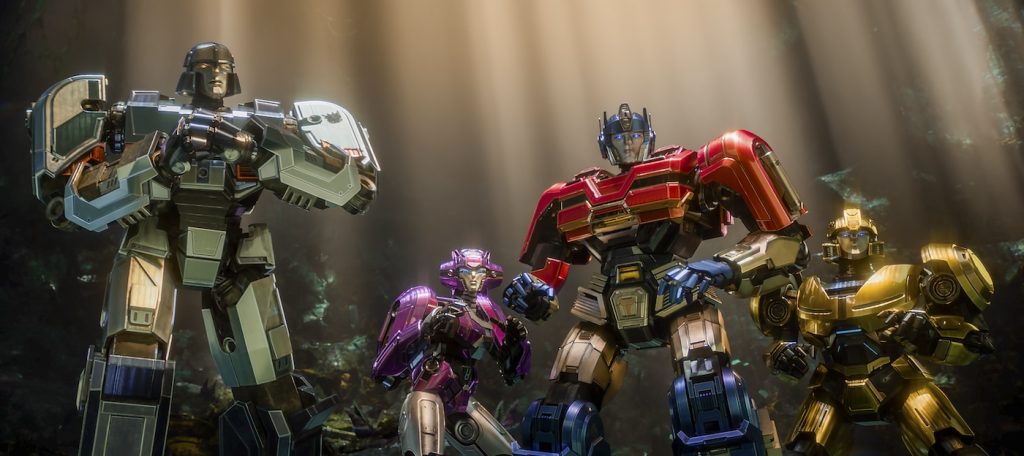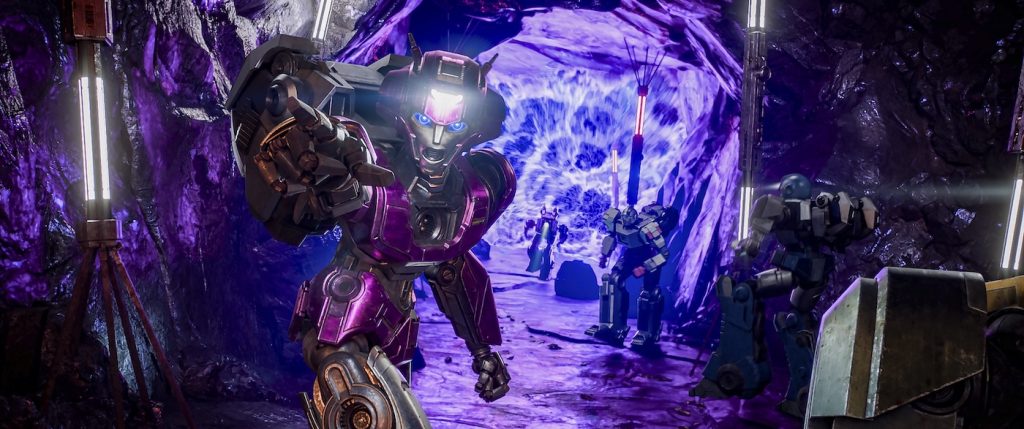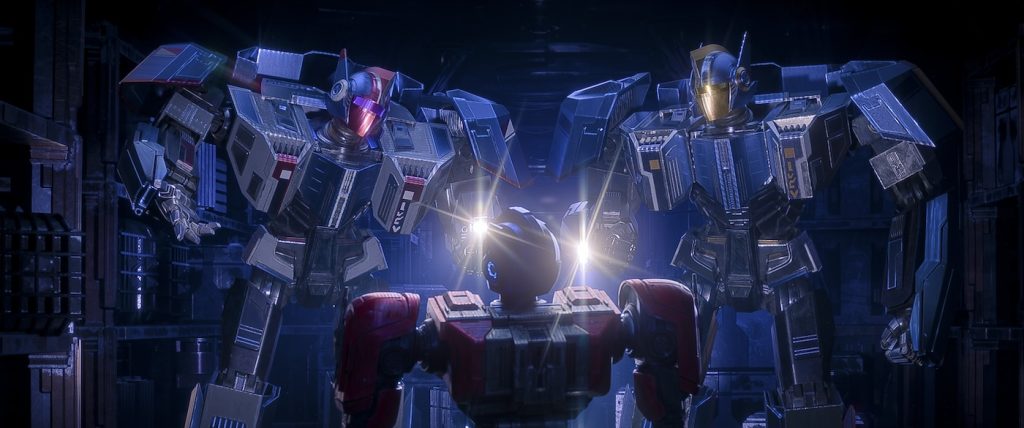Prime Directive: “Transformers One”‘ Writers Andrew Barrer and Gabriel Ferrari on Crafting an Epic Origin Story
When it comes to toy-inspired movie franchises, Hasbro’s Optimus Prime beat Mattel’s Barbie to the punch by several decades. The franchise includes a 1986 cartoon feature, five Michael Bay movies, and two spinoffs. The seemingly never-ending battle between Autobots and Decepticons finally gets its backstory in the animated prequel Transformers One. Featuring the voices of Chris Hemsworth, Brian Tyree Henry, Scarlett Johansson, and Keegan-Michael Key, the movie follows a young Optimus Prime (Hemsworth) and Megatron (Henry) before they become arch-enemies.
Writing partners Andrew Barrer and Gabriel Ferrari teamed with Black Widow scribe Eric Pearson on the Transforms Origins script after showcasing their action comedy chops on Ant-Man and Ant-Man and the Wasp. “That made us good candidates for working on bright, adventurous, world-building IP, which initially helped us get the attention of Hasbro,” says Barrer.
Barrer, speaking from his suburban Philadelphia home and Ferrari, in his Long Island headquarters, recounts their own origin story, describes “Transformers School” and explains how Stand By Me inspired their concept for Transformers One.
Congratulations on coming up with a fresh take on the Transformers characters nine movies into the franchise. I’m curious about the origins story behind your origins story movie.
Andrew Barrer: We jumped on the project, probably in 2013 when Hasbro Studios approached us to make an animated movie. Then [in 2015], we were down in Mexico in the desert when we got a call from [writer-producer] Akiva [Goldsman] asking us to be part of this writer’s room. The idea was to brainstorm what a Transformers cinematic universe would look like, and then, at a certain point, individual writers broke off and cooked up what their segment might be. So we went up to Los Angeles, and they put us through Transformers school, where you learn all the ins and outs of the canon. But we already had our take. Our mantra was always Stand By Me with robots. Our goal was to write a story where these characters would be interesting even if they weren’t robots.

How did your screenplay evolve over the years?
Gabriel Ferrari: Going in, we knew this would just be on [the planet] Cybertron and we knew there would be no human characters, and we wanted our script to be part of this interconnected mythology that came out of that [writers] room, but the script went through many iterations. It wasn’t really until Paramount Animation came on and said that they wanted to do an origins story per your pitch in an animated format. That’s when we landed on this more youthful tone that didn’t have much to do with the previous continuity. It was kind of its own thing. And then Josh [Cooley] from Toy Story 4 came in to direct.
Andrew: That’s when the tone and the aesthetic approach solidified because Josh is one of the funniest people on the planet.
Did you initially connect in Brooklyn as writing partners?
Andrew: We’ve actually been friends since we met freshman year at NYU.
Gabriel: Andrew was studying philosophy, and I was an art student.
So, neither of you actually studied film. Did you collaborate on other stuff?
Andrew: In our junior year, we went to Croatia for a photojournalism project on war generation and made a little book. But it wasn’t until after college, living in Chinatown, that we talked about writing a screenplay.
Gabriel: Our process was weird. Since we hadn’t studied film or screenwriting, our knowledge was rudimentary, and we had to learn on our feet with our first script, Die in a Gun Fight. We gave it to our friend Steve, who took it to a producer, who got Zac Efron on board, and from that, we got agents, and our script was on the Blacklist. That launched us.

A few years later, Marvel calls you in at the last minute to re-write Ant-Man?
Andrew: Yeah. Edgar Wright left the first Ant-Man very late in the game, just three weeks before production after full sets had been built, and they quickly swapped in director Peyton Reed. We went down to Atlanta at the drop of a hat and worked on set.
Gabriel: We worked around the clock, and everyone felt the pressure.
Andrew: Even though we didn’t get our names on it, we had to be the last writers to touch a lot of the humor, jokes, and dialogue.
Gabriel: But we came through in the clutch, and the sentiment [from the studio] was, “Let’s bring them back for Ant-Man and the Wasp. They earned it.”

The Ant-Man work then leads to this movie. When you were kids, did you guys play with Transformers action figures?
Andrew: I was actually pretty bad as a kid. There’s a joke in the movie about not being getting them to transform fully. Gabriel probably played with them more?
Gabriel: And I definitely watched the Saturday morning cartoons. Then, I saw the Shia Labeouf/Michael Bay movies over the years. Bay did his thing and made it wildly successful, but now we’re at a point in time where a lot of people out there maybe don’t remember or don’t care what the old movies were like. They might be coming to Transformers for the first time, so we were given an opportunity to explore a different way forward, being faithful to much of the old but with the tone maybe feeling more modern for a new era.
Andrew: Particularly because it’s an origins story, there’s a mythological thing happening. It’s like Exodus, it’s Ben Hur, it’s Shakespearean. For us, it was about “Let’s stop thinking about clanking metal and think about Megatron and Optimus as this brotherhood that tragically crumbles.”
Yet, the story details still need to fit within the world of Transformers.
Andrew: Yes. Part of Hasbro school was that there are facts in Cybertronian culture, like what Energon is, what a spark is, and what a Transformer cog is. You can’t just make it up as you go along.
Gabriel: There’s a committee over there at Hasbro who live and breathe this stuff, so sometimes they’d say, “Ah, you can’t do that; it’s not so good for the Transformers brand.

Your story stars sentient robots, and of course, artificial intelligence (AI) has come to play an increasingly powerful role in society over the past few years. How has AI impacted your craft?
Gabriel: AI has not crept into our lives as writers so much.
Andrew: I’m not going to pooh-pooh new methodologies, but I would describe myself as an artist, and I can’t help but see AI as a performance-enhancing drug that you have to be careful about.
You two first hatched your concept for the film back in 2013, and eleven years later, Transformers One is about to hit theaters. What do you hope audiences take away from this movie?
Andrew: That it’s awesome and fun and a good cinematic experience that you should really watch together with other people in a movie theater.

For more films and series from Paramount and Paramount+, check out these stories:
Ridley Scott’s “Gladiator II” Unsheathes Ferocious New Trailer
“Sonic the Hedgehog 3” Trailer Shines a Light on Keanu Reeves’ Shadow
Featured image: L-r, Keegan-Michael Key (B-127), Brian Tyree Henry (D-16), Chris Hemsworth (Orion Pax), and Scarlett Johansson (Elita-1) star in “TRANSFORMERS ONE.” Courtesy Paramount Pictures/Hasbro.



